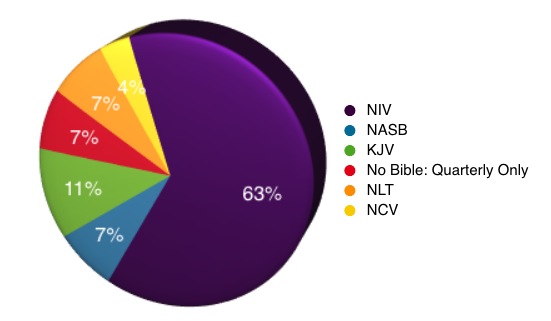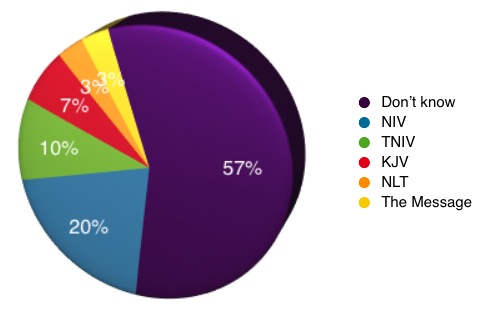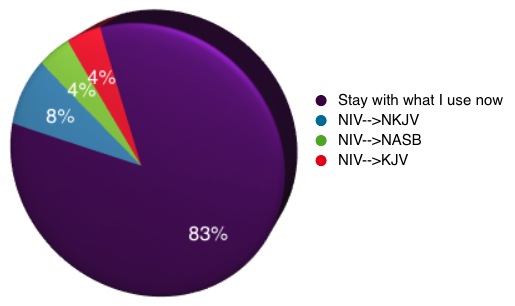Bible Translation Awareness Survey Results
04/30/2007 08:33 Filed in: Faith & Reason

This was actually the third week I'd carried the survey with me as I was waiting for an ideal representation of our roll to respond. Yesterday we had 35 class members in attendance, no visitors, and about 10 of our regular attenders were absent. I handed out 35 surveys, but only got back 26. We are in a Southern Baptist church, and our class uses Southern Baptist curriculum.
Here is how I introduced the survey on the form I handed out to everyone:
Augustine said that it was profitable to study the Bible with parallel translations. On any given Sunday morning, there are multiple translations of the Bible represented in our Quest Bible Study—and that’s a good thing! This survey will help your teacher in his preparation by knowing what translations are in use in the class by what percentages of learners. Also, it will help him gauge your awareness of translations. Please answer the questions as honestly as possible.
Here are the results of the survey:
Q1. What translation of the Bible are you using this morning? [I had a list of translations to choose from including an option for other and an option for the Sunday School quarterly instead of a Bible]

- 2 said they didn't bring a Bible, but were using a quarterly. This means they had access to the HCSB and KJV.
- 17 members were using the NIV. Our pastor preaches from the NIV, and of course, the NIV is the most popular translation in the US, so it no surprise that almost 2/3 of the class were using this version.
- 3 were using the KJV.
- 2 were using the NASB.
- 2 were using the NLT (I didn't specify which edition in the survey).
- We had one person respond saying he was using the NCV. I know of one other person in the class who uses the NCV, but he wasn't there today.
Q2. Did you know what translation you were using, or did you have to look at your Bible to double-check? [This was my awareness test. Assuming they answered truthfully, more folks are aware of their translation than what I would have imagined.]
Twenty-two answered "I knew"; three answered "I had to double-check."
Q3. What translation of the Bible does your teacher use? Don't guess. If you don't know, write, "I don't know."

- 15 respondents said they didn't know what translation I was using.
- 6 said that I was using the NIV.
- 3 said I was using the TNIV.
- 2 guessed I was using the KJV!
- 1 suggested the NLT
- 1 thought I was using the Message.
The correct answer is that I use the TNIV. When we started the class last March with less than a dozen members, I was teaching from the HCSB because it is the primary translation in the Sunday School quarterly. However, last fall while teaching through Hebrews, I switched to the TNIV, so I've been using that for about six months. I did use the Message one time a few weeks ago to read through an extended passage in Esther. I mentioned that I was reading from that version, and that name must've stuck with someone. I have never and would never use the KJV to teach a regular Sunday School class. I've used the KJV occasionally in other venues, especially when speaking to senior adults.
I mention now and then that I am reading from the TNIV, but I don't make a big deal out of it.
Q4. When you study your Bible at home, do you ever use another translation? If so, list what you would consider your primary translation, and what you would consider any secondary translation(s). If you never study your Bible at home, simply write, “I never study my Bible at home” (this survey IS anonymous!).
One person admitted that no Bible study ever takes place at home. Here are the rest of the results:
Primary translations:
- NIV: 17
- NLT: 2
- KJV: 2
- NASB: 1
Secondary translations:
- KJV: 6
- NIV: 2
- NASB: 2
- HCSB 1
- NCV: 1
- NKJV: 1
- Amplified: 1
- Phillips NT: 1
Q5. If you lost your main Bible and had to buy a new one this week, would you buy the same translation you checked in question #1 or would you get a different one? If you would get a different one, what would it be?

- 20 of those surveyed said that if they had to replace their Bibles, they would stick with the translation they currently use.
- Two said they would switch from the NIV to the NKJV.
- One indicated a switch from the NIV to the NASB.
- One said a switch from the NIV to KJV would take place.
Again, for anyone else, these results are simply anecdotal. But the majority of my class using the NIV reflects national trends. Further, if there're any broader implications to be drawn, question #5 would indicate that people don't change translations very often or very easily. Most importantly, my choice to teach from the TNIV is a good one with most of the class' members reading from the NIV. They can follow easily enough when I read from the TNIV as there is much continuity from their version, but at the same time the TNIV offers a more accurate and up-to-date option over the NIV.
One last thought... to my knowledge, there's been no recent class at our church about the history of English translations and the differences between them. I wonder if any of the questions would be answered differently if such a discussion took place prior to such a survey?
Link: Bible Translation Awareness Survey









